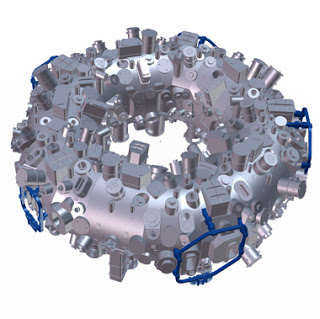In the three-year project, starting in 2011, scientists from the fusion institutes at Princeton, Oak Ridge and Los Alamos are contributing auxiliary magnetic coils, measuring instruments and planning of special sections of the wall cladding for equipping the German fusion device. In return, the USA will accordingly become a partner in the Wendelstein 7-X research programme.
The Wendelstein 7-X fusion device will be the world’s largest and most modern device of the stellarator type. Its magnetic field makes continuous operation possible by simple means. W 7-X aims at producing 30 minute pulses, a duration that is limited only by the cooling power of the installation.
How stellarators are different from tokamaks?
In a stellarator, confining the plasma is like holding a broomstick firmly in your fist; in a tokamak, it’s like trying to balance the same broomstick on your finger.
Stellarators produce intrinsically stable plasmas with no or only modest electrical currents flowing through them; tokamaks, with very strong plasma currents, must devise complex ways of maintaining their equilibrium. “Both are terrible beasts,” smiles the Scientific Director of W 7-X. “Ours is a beast to build; yours is a beast to operate.”
Wendelstein 7-X is mainly a toroid, consisting of 50 non-planar and 20 planar superconducting magnetic coils, 3.5 m high, which induce a magnetic field that prevents the plasma from colliding with the reactor walls. The 50 non-planar coils are used for adjusting the magnetic field.
The main components are the magnetic coils, cryostat, plasma vessel, divertor and heating systems.
The coils are arranged around a heat insulating cladding which is 16 meters in diameter called the cryostat. A cooling device produces enough liquid helium to carry away 5,000 watts of heating power to cool down the magnets and their enclosure (about 425 metric tons) to superconductivity temperature. The plasma vessel, built of 20 parts, is on the inside, adjusted to the complex shape of the magnetic field. It has 299 holes for plasma heating and observation diagnostics. The whole plant is built of 5 almost identical modules, which are assembled in the experiment hall.
Objectives
* Prove the success of the stellarator optimisation concept: Improved particle and energy confinement and stable plasma equilibrium under conditions like those in a power plant
* Operation at maximum plasma pressure and beta values (plasma pressure relative to the counter pressure from the magnetic field) of 4 to 5 percent, as required for a reactor
* Application of effective non-ohmic heating methods to produce and heat the plasma under steady state conditions
* Investigation of the impurity transport and development of methods of impurity control
* Long-time and quasi-stationary operation for all device components
* Control of plasma-wall interaction, particle recycling and refuelling under the conditions of continuous operation by means of a divertor at the plasma boundary
53 page presentation on Wendelstein 7 X
If you liked this article, please give it a quick review on ycombinator or StumbleUpon. Thanks

Brian Wang is a Futurist Thought Leader and a popular Science blogger with 1 million readers per month. His blog Nextbigfuture.com is ranked #1 Science News Blog. It covers many disruptive technology and trends including Space, Robotics, Artificial Intelligence, Medicine, Anti-aging Biotechnology, and Nanotechnology.
Known for identifying cutting edge technologies, he is currently a Co-Founder of a startup and fundraiser for high potential early-stage companies. He is the Head of Research for Allocations for deep technology investments and an Angel Investor at Space Angels.
A frequent speaker at corporations, he has been a TEDx speaker, a Singularity University speaker and guest at numerous interviews for radio and podcasts. He is open to public speaking and advising engagements.





